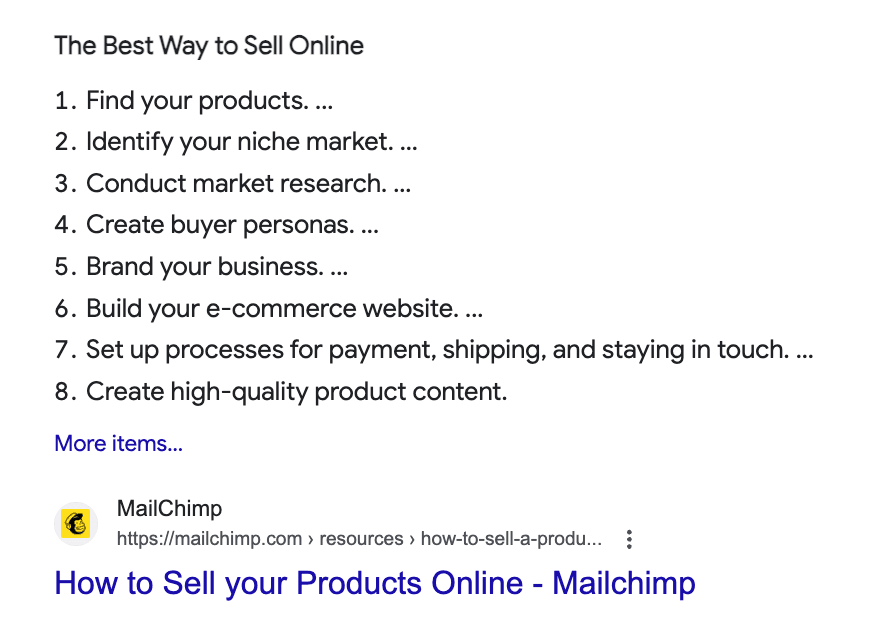SEO content is a critical component of digital marketing and greatly impacts attracting new potential customers. Although more and more AI content generation tools are on the market, creating high-quality articles and other SEO-optimized marketing materials can still bring huge benefits to your business.
If you’re wondering what those benefits are, what SEO content is, and how to create it – dive into this article! You’ll find here 6 valuable tips to learn how to write SEO content to help your company achieve its business goals.
What is SEO content?
Let’s start with the theory of what SEO content actually is. In simple language, it is content aimed at achieving the highest possible positions in the so-called Search Engine Results Page (SERP).
However, contrary to popular assumptions among many, it doesn’t just involve placing keywords in an article. It is a meticulously planned process in which the main goal should be to provide as much value to the user as possible (as highlighted by Google, for example).
To achieve this, it is therefore essential to provide content that matches the user’s search intents and ensure that the user responds quickly – in terms of information and the way it is provided. Well-optimized SEO content should be built around strategic keywords, include relevant internal and external links and metadata, and integrate other SEO-critical elements.
All this is done with the utmost attention to the end user’s readability, uniqueness, and value. In today’s digital landscape flooded by similar content, only such a comprehensive approach can ensure high search engine rankings and encourage your readers to interact further with your company.
Why is it Important to Write SEO Content?
There are a mass of SEO content benefits, and the most important are:
- Increased Visibility on SERPs: A remarkable 54.4% of all clicks go to the top 5 results on Google. By optimizing your content with SEO techniques, you enhance the likelihood of your content securing one of these coveted spots, ensuring it captures the attention of your target audience.
- High-Quality Leads: According to HubSpot, 60% of marketers affirm that inbound techniques like SEO and blog content creation are their superior source of quality leads.
- Improved User Engagement: High-quality, SEO-optimized content provides valuable information, keeps readers engaged, and prompts them to interact more with the site.
How to Write SEO Content to Rank in the SERP’s Top Results?
Alright, let’s get to the crux of the article. Below, we’ve listed 6 tips for top rankings. Let’s dive in!
1. Conduct Keyword Research
The first step to start with is keyword research. It involves discovering, evaluating, and selecting the best keywords to attract targeted traffic to your content via search engines.
But why do it? It will help you know the exact words your audience is typing into search engines and show you how to improve existing content and create new content to match what they seek. By using the right keywords, you can get more people to see your content, and that’s a chance to get valuable business leads.
How to Conduct Keyword Research
1. Identify your target audience: To conduct keyword research effectively, prepare a detailed profile of your ideal customer. Constructing a buyer persona helps you understand your existing and prospective clients’ shared traits, daily struggles, and expectations. If your business operates in a specific area, this step also lays the foundation for local keyword research, helping you align your content with the geographic intent of your audience.This insight not only aids in identifying relevant keywords for your website content but contributes significantly to shaping your broader business strategy.
2. Brainstorm keyword ideas: Once you have a buyer persona, think about what they might type into a search engine. But remember to look deeper into all of this. For example, if you sell shoes, your customer doesn’t have to type in “shoe store” immediately. He can also type in “shoes – trends for fall 2024.” It is worthwhile to tailor your content to people at different stages of considering a particular purchase. Talking to your sales team will be very helpful here, as they regularly interact with customers and can tell you what their customers ask most often.
While targeting keywords with high search volumes is tempting, these can be highly competitive. It might be more effective to focus on specific or long-tail keywords. For instance, instead of just using “Digital Marketing”, you might find more success with “Digital marketing tips for software houses” because it’s more specific and faces less competition.
3. Gather Keyword Suggestions: There are many SEO tools available that offer keyword ideas. These tools can provide an extensive list of keyword suggestions, indicating how frequently people search for them and the associated ranking difficulty. A keyword ranking tool can help you track how well your selected keywords are performing in search engine rankings
Paid tools offer exhaustive keyword suggestions, allowing you to analyze parameters such as search volume or difficulty score and scrutinize competitor activities. If you’re not ready to invest now, Google’s search features like autocomplete, People Also Ask, and Related Searches can serve as valuable resources.
4. Refine Your List: Although many keywords might seem tempting to target, it’s essential to prioritize for the best ROI. Group your keywords by relevance and search intent, keeping only those that align with your business goals.
5. Construct a Keyword Map: Allocate target keywords to specific pages on your website, ensuring each keyword matches a page that aligns closely with the searcher’s intent. It is vital, as such a page is more likely to achieve a top rank on SERPs.
In keyword mapping, it’s crucial to associate pages with keyword clusters rather than individual keywords. It means grouping similar keywords; for instance, “luxury leather boots” and “high-end leather footwear” might address the same user intent. This strategy not only prevents potential content overlap but also sets the stage for improved rankings across multiple keywords.
2. Audit Your Available Content
Another good practice in writing SEO content is a content audit. It thoroughly examines the content generated to determine its effectiveness in meeting audience requirements. This systematic review can encompass the entire blog, specific categories within the blog, selected landing pages, or all digital assets.
This practice will provide a clear perspective on which pieces of content on your platform need refinement, updating, repurposing, or even removal. This meticulous approach also aids in bridging the gaps, enabling you to offer a superior experience to your audience.
So, what does it take to conduct such a content audit?
- Set Audit Goals: As with any process, establish a measurable goal and align it with pertinent metrics. For instance, if your objective is to enhance engagement levels, monitor metrics like average CTR, the number of pages viewed per session, and session duration.
- Structure Your Content: Compile all content URLs into one location, preferably a spreadsheet. Then, categorize each entry based on criteria like title, publication date, word count, content format, embedded links, and other vital factors influencing your company’s trajectory.
- Check for Plagiarism: A crucial part of any audit is verifying originality. Even unintentionally duplicated content can harm your rankings and credibility. Using a free online plagiarism checker ensures that your existing articles are unique and not inadvertently overlapping with external sources. This step protects your site’s SEO value and strengthens trust with your audience.
- Use Analytics Tools: Harness SEO tools to obtain in-depth data on your content. After thoroughly analyzing these metrics, determine which content to retain, modify, and which to remove.
- Establish an Action Plan: For each content piece, devise a distinct strategy rooted in the goals set during the initial audit phase.
It’s essential to note that regular audits are crucial. We suggest undertaking this process every six months to ensure your content consistently aligns with evolving business objectives.
3. Create a Content Plan

An example of a content plan created in ClickUp
Your plan should include not only the articles you intend to write but also existing ones on your blog, as regular updates are crucial.
The content plan should be informed by your content audit and consider factors like search volume and the difficulty of predefined keyword clusters.
It’s essential to remember that every piece of content you create should center around a specific keyword. Since users have varied search intentions, it’s beneficial to delve into related long-tail keywords, potential questions, and trending topics. This strategy can help you pinpoint opportunities that resonate with your primary keyword.
In devising your content plan, factor in elements like the target audience, the article’s objective, internal linking, and the call-to-action (CTA) positioned at the article’s conclusion. Every content piece should serve a distinct goal, whether it’s prompting readers to download an ebook, request a free demo, or schedule a meeting with your team. This strategy guides users through your website based on their position in the marketing funnel and the specific page they’re browsing.
4. Write Informative and Engaging Content
It’s time to get writing. While crafting SEO-optimized content, always prioritize your audience by delivering valuable insights.
Search engines like Google often favor user-centric content over keyword-saturated pieces. Emphasize unique expert knowledge, ensuring that what you produce isn’t just another piece of content of what’s already available online. For added credibility, consider referencing research and reports.
Beyond imparting knowledge, strive for readability. Organize your content logically, using headings and subheadings to guide readers through your main points. Introducing elements like lists or quotes can enhance user engagement and clarity.

An example of using a quote in the article. Source: Zoom
5. Optimize Your Content for SEO
While crafting your content, integrate your target keywords seamlessly. However, exercise restraint. Overloading your material with tangentially related keywords can dilute its focus, making it sound forced. It deters readers and risks suboptimal ranking for your primary keyword.
Additionally, in terms of optimizing your content for better visibility, it’s crucial to craft compelling title tags and meta descriptions. They act as a snapshot of your content, enticing users to click, and can significantly improve the click-through rate from SERPs.
Consider incorporating internal and external links in your content for a more comprehensive approach. Ensure these links are pertinent and beneficial for your readers. The anchor text should be descriptive, offering readers a clear idea of the linked content. For optimal SEO outcomes, regularly check the functionality of all links to avoid broken or misdirected redirects. Various SEO tools with page audit features can assist in this endeavor.
Lastly, contemplate implementing schema markup.

An example of schema markup.
This advanced SEO technique can elevate your content’s eligibility for rich results on SERPs, offering users a richer preview and enhancing your online presence.
6. Promote Your Content
You already have SEO-optimized, high-quality content. What’s next? Before diving into paid advertising, consider prioritizing organic promotion. Begin by sharing your article on your company’s social media channels. Additionally, post it in groups that focus on your topic.
Instagram stands out as one of the major social media platforms. If you’re thinking about creating Instagram video content, try leveraging online tools like a reel maker. These tools can elevate your videos, giving them a professional touch, and ultimately help you expand your reach across platforms like Instagram.
Moreover, never underestimate the power of backlinks from reputable websites. Ensure these links blend seamlessly within relevant content, with anchor texts preferably containing your target keywords. This approach doesn’t just amplify your content’s worth; it also bolsters its credibility in the eyes of search engines like Google.
A crucial part of any audit is verifying originality. Even unintentionally duplicated content can harm your rankings and credibility. Using a free online plagiarism checker ensures that your existing articles are unique and not inadvertently overlapping with external sources. This step protects your site’s SEO value and strengthens trust with your audience.
However, always prioritize quality over quantity. Links from less credible websites might not yield the desired results. For backlink research and strategy formulation, tools like SE Ranking are invaluable, or you might think about collaborating with an SEO Driven Service Company.
Conclusion
Getting listed in the first search results doesn’t have to be difficult, even if you’re competing with larger companies than yours. Providing value to users and ensuring your content is unique is paramount. When you combine this with the SEO optimization techniques we’ve discussed above, your efforts will yield results in the end. Good luck!










Leave a Comment
Your email address will not be published. Required fields are marked *